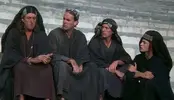Paris
What is love?
The ancient Egyptian calendar was a solar calendar based on the movements of the sun. It consisted of 365 days divided into 12 months of 30 days each, with five additional days added at the end of the year to make up the difference between the 365-day solar year and the actual time it takes for the earth to complete one orbit around the sun.
Each month was further divided into three ten-day weeks, called "decans," which were named after the three main stars that rose above the horizon during that period.
The names of the months in the ancient Egyptian calendar were:
The ancient Egyptians used a variety of astronomical observations and calculations to keep the calendar in sync with the solar year, including the rising of certain stars and the timing of solstices and equinoxes. Over time, the calendar was adjusted to more closely match the actual length of the solar year, but it still drifted over time and required occasional adjustments.
The ancient Egyptian calendar remained in use throughout much of Egyptian history, including during the periods of the Old, Middle, and New Kingdoms, as well as during the Ptolemaic period, which began after Alexander the Great conquered Egypt in 332 BC. The calendar continued to be used in various forms for several centuries after the end of the ancient Egyptian civilization.
Each month was further divided into three ten-day weeks, called "decans," which were named after the three main stars that rose above the horizon during that period.
The names of the months in the ancient Egyptian calendar were:
- Thoth
- Paopi
- Hathor
- Koiak
- Tybi
- Mekhir
- Phamenoth
- Pharmuthi
- Pachons
- Payni
- Epiphi
- Mesore
The ancient Egyptians used a variety of astronomical observations and calculations to keep the calendar in sync with the solar year, including the rising of certain stars and the timing of solstices and equinoxes. Over time, the calendar was adjusted to more closely match the actual length of the solar year, but it still drifted over time and required occasional adjustments.
The ancient Egyptian calendar remained in use throughout much of Egyptian history, including during the periods of the Old, Middle, and New Kingdoms, as well as during the Ptolemaic period, which began after Alexander the Great conquered Egypt in 332 BC. The calendar continued to be used in various forms for several centuries after the end of the ancient Egyptian civilization.










